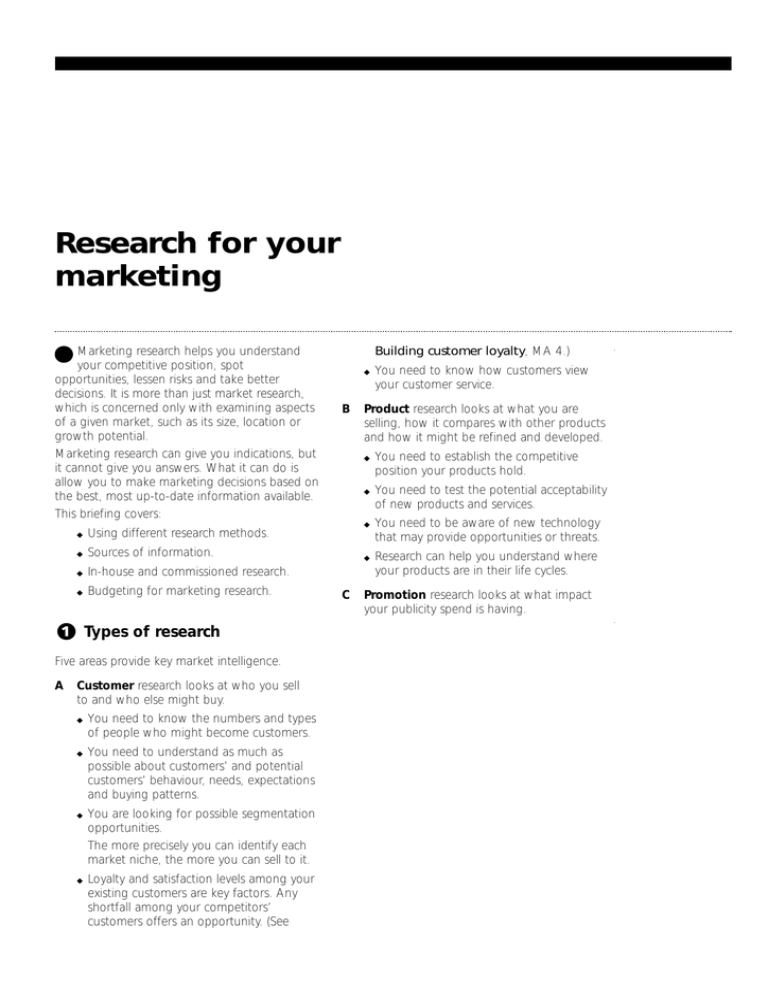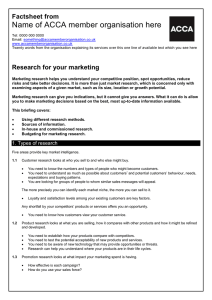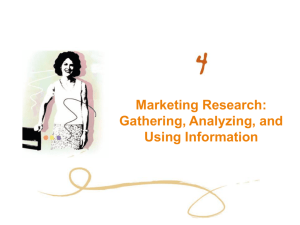Research for your marketing
advertisement

Research for your marketing Marketing research helps you understand your competitive position, spot opportunities, lessen risks and take better decisions. It is more than just market research, which is concerned only with examining aspects of a given market, such as its size, location or growth potential. Marketing research can give you indications, but it cannot give you answers. What it can do is allow you to make marketing decisions based on the best, most up-to-date information available. This briefing covers: ◆ Using different research methods. ◆ Sources of information. ◆ In-house and commissioned research. ◆ Budgeting for marketing research. Types of research Five areas provide key market intelligence. A Customer research looks at who you sell to and who else might buy. ◆ You need to know the numbers and types of people who might become customers. ◆ You need to understand as much as possible about customers’ and potential customers’ behaviour, needs, expectations and buying patterns. ◆ You are looking for possible segmentation opportunities. The more precisely you can identify each market niche, the more you can sell to it. ◆ Loyalty and satisfaction levels among your existing customers are key factors. Any shortfall among your competitors’ customers offers an opportunity. (See Building customer loyalty, MA 4.) ◆ B C You need to know how customers view your customer service. Product research looks at what you are selling, how it compares with other products and how it might be refined and developed. ◆ You need to establish the competitive position your products hold. ◆ You need to test the potential acceptability of new products and services. ◆ You need to be aware of new technology that may provide opportunities or threats. ◆ Research can help you understand where your products are in their life cycles. Promotion research looks at what impact your publicity spend is having. ◆ How effective is your activity? ◆ How do you use your sales force (including telesales)? ◆ How effective are your advertising, pointof-sale materials, mailshots and website? ◆ Does your company’s image help — or does it work against you? You may not be aware, until you do the research, of all the direct and indirect channels your product passes through. D Pricing research tests whether you could be selling your product for more. (See Pricing, MA 8.) E ◆ Investigate perceptions of price versus value, both among customers and among non-customers in your target markets. ◆ You need to know whether your product’s positioning is right for its price point. ◆ Full and up-to-date data on competitors’ prices is an important factor in many business decisions. ◆ You need to know, preferably before you try them out, what the effects of discounts or loyalty bonuses would be. Distribution research examines how your product gets to the marketplace. B For example, someone thinking of starting a fitness club might survey a sample of people in the catchment area. Of those potentially interested, the study might show 20 per cent already linked to other clubs, 75 per cent with other fitness strategies and just five per cent likely to consider joining. This would be a clear warning not to go ahead as planned. Good qualitative research may reveal information that can lead to new strategies and new business ideas. ◆ The fitness entrepreneur may investigate how people struggle to find time to combine exercise with their social lives. The answers may lead to a different approach. For example, a fitness club with luxurious facilities and a bar, to encourage members to stay and relax together after working out. ◆ Does the bulk packaging of your goods help or hinder your sales? ◆ Are the transport methods you use costeffective and appropriate to the size, weight and fragility of your product? Do your delivery times suit the customers? What do you need to know? You need to know what you want from the research before you can decide on the depth, methods and justifiable budget. A Use exploratory research for ‘quick and dirty’ clues to aid real-time decision making. ◆ Research results provide an important reality check, to stop you being too convinced by your own assumptions. Numerical and motivational information can often be combined to modify an idea and convert a potential failure into a success. ◆ Who are the intermediaries that stand between you and your customers? Do the brokers or wholesalers who matter recommend you to end-users? It is easy to do too much research. Nice-to-know information is a luxury. Focus on critical factors in your key markets. Data you can use A If the numbers deliver a clear negative signal, do not ignore it. ◆ For example, are there local customers for your domestic plumbing service who do not even know you exist? If so, a door-todoor leaflet drop may bring good results. This initial research may uncover the need for more detailed analysis. Exploratory research will often tell you why a product or service is not working, or why one product sells more than another. B Invest in detailed research when you need to put flesh on the bone. ◆ C You will want concrete, detailed data to inform your planning decisions. For example, how many high-income families within ten minutes’ drive of your office might be in the market for outdoor jacuzzi installations costing £2,000 each? Causal research can be extremely valuable, but is often hard to carry out and interpret. It is aimed at answering ‘what-if’ questions. ◆ For example, how would raising your prices affect your sales volume? Desk research Where it is appropriate, desk research is the cheapest and quickest research of all. It can be very useful for broad-brush exploratory work. Much of the data will be available to you at little page 2 or no cost, from internal or public sources. associations, trade press and professional journals, business magazines and the business pages of the national (especially broadsheet) newspapers. For example, data from these sources will help you understand the size of national and regional markets for your products. A Internal sources are free, reliable and usually instantly available. They can yield valuable data about sales volumes, buying patterns, customer size and location and causes of dissatisfaction. ◆ ◆ B The key sources are account records, sales reports, customer records and records of queries and complaints. Do not ignore informal feedback from your employees. Your internal sources may not be set up to make access to this kind of data easy. You may need to change your methods of recording information. (See Filing and records management, ST 15.) There is a wealth of external sources to investigate, especially the Internet. See Finding information on the Internet, IT 13, and Useful Internet sites, IT 16. External data will be especially important when you are launching new products, entering new markets or starting a business. ◆ Major sources include government statistics (UK and foreign), trade Just two quick questions Micro businesses often cannot afford marketing research. But they can carry out some useful DIY ‘dipstick research’. Half a day on the phone to your customers, asking just two key questions, can make a vital difference to your chances of success. ◆ Universities and research organisations can often provide specialised technical data. ◆ Your local Business Link can give useful local, regional and UK survey information. ◆ A wide range of data is available commercially on a syndicated basis, with detailed, highly specialised reports costing a few hundred pounds each. Always check survey dates, as old data can be dangerously misleading. The external data you find may not be in useful forms. It may have been collected for other purposes, or be from a sample that does not tally with your target group. Field research Field research is usually more expensive and difficult to organise than desk research. There are three main ways of gathering data. A Use questions to reveal what people think. ◆ The best form of questioning is usually face to face (singly or in groups). ◆ Interviewing by phone is cheaper, but demands good technique and may be less revealing. People may resent the call, or you may not have their full attention. ◆ Postal questionnaires are cheap — and you may be able to piggyback on your own existing mailings. Email is even cheaper. Make questionnaires easy to respond to. All written surveys produce low response rates and those who reply will be a selfselecting group, which may be untypical. For example, pensioners may be overrepresented in postal surveys. A Identify 20 top customers and ask them who they think you are competing with. ◆ B Ask each of the customers: “Who do you see as my competitors?” A litho printer who did this was surprised to find that his advertising agency customers did not compare him with other two-colour printers, but with four-colour printers in the area. Then ask your customers how they make their buying decisions. ◆ Ask them: “What makes you use us, rather than the others?” The litho printer had assumed customers bought from him almost wholly on price. He discovered that reliability and quality were what kept them coming back. As a result of his afternoon on the phone, the printer shifted the emphasis of his marketing. He targeted his activities at larger ad agencies, and soon found that many of his jobs could safely carry much healthier margins. Make survey questions open-ended, so they cannot be answered with a yes or a no. B Use observation to reveal what people do, rather than what they say or think they do. ◆ C For example, how do shoppers behave at a particular point-of-sale display? Use experiments to see what people will do in a particular, controlled situation. ◆ For example, will people choose your page 3 cakes in blind tasting tests? The usefulness of field research depends on the clarity of the questions, the reliability of the sample, the researcher’s skill and the clever interpretation of the data that is collected. D There must be a realistic budget to cover the costs involved. ◆ You may have to pay for the printing, and perhaps mailing, of questionnaires. ◆ You may have to pay to hire a hall — or even a research lab, where you can video the discussion and observe people’s reactions through one-way mirrors. ◆ You will have to pay respondents’ travel expenses. Focus group participants are often paid a small incentive. This is usually £20 to £30. Quantity or quality? A You must base quantitative research on samples that are big enough to give reliable information, if you aim to establish statistically valid data. ◆ ◆ B This means that your survey must usually involve questioning at least 150 people. Scripts must be used, to make sure all participants in the study are asked exactly the same questions. When you need to know about people’s feelings and motivation, you must use qualitative research methods. These are concerned with depth, rather than breadth. ◆ ◆ ◆ Participants are encouraged to give detailed answers and discuss their opinions, rather than just replying to a strict questionnaire. Qualitative research is often done in small groups, known as focus groups. Choosing an outside agency Small businesses often cannot use agencies, because most agencies will not work on projects where the budget is less than £3,000 to £5,000. This is not greed. If you cannot afford enough interviews, your results will not be reliable. A Find out what kind of reputation the agency you are considering has (in general and in the particular area of research). ◆ B Allow plenty of time for qualitative work. It always takes longer than you expect. Decide how comfortable you would feel about working with the research agency. ◆ Do you trust the people you have met? ◆ What relevant experience and qualifications do its employees have? You can find an agency with the skills you need by calling the British Market Research Association’s Selectline service (0800 801 785) or visiting the Selectline website at www.bmra.org.uk/selectline. You can also find over 500 agencies listed online in The Research Buyer’s Guide (www.rbg.org.uk). Contact the Market Research Society to obtain a printed copy for £40 plus p&p (020 7566 1851). The Chartered Institute of Marketing (01628 427500) also offers a list of accredited agencies. Qualitative research is harder to analyse than quantitative research. The danger is that you allow the opinions of the loudest or most talkative members of a group to carry too much weight. Talking to customers and ‘keeping your ear to the ground’ are familiar low-key forms of qualitative research. Can you do it yourself? Non-specialist desk research can usually be handled in-house. DIY field research will only work if it is set up properly, right from the start. A You must be clear what data you require. B Be realistic about the likely scale of fees. ◆ Fees will reflect the work to be done and the agency’s supposed status. ◆ Can the project be scaled down? You will need certain technical skills. ◆ For example, in designing questionnaires and running focus group discussions about new products or advertising. If you and your employees do not have relevant experience, it may be a false economy not to call in some outside help. C C You must give the individuals doing the research enough time to do it properly. What do previous clients say? D Consider whether you should be using a freelance researcher. ◆ A freelance may be the best affordable option, especially for qualitative work. ◆ The Research Buyer’s Guide (see B, above) also has a useful list of recognised freelance research practitioners. page 4




